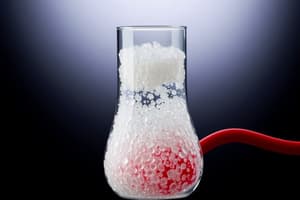Podcast
Questions and Answers
Why doesn't increased sodium, the major ECF ion, always affect ECF osmolarity?
Why doesn't increased sodium, the major ECF ion, always affect ECF osmolarity?
- ECF osmolarity is primarily determined by potassium levels, not sodium.
- The effect of sodium on osmolarity is offset by changes in water volume.
- Sodium concentration is independent of total sodium amount. (correct)
- Changes in sodium concentration are immediately buffered by intracellular mechanisms.
What is the primary effect of increased vascular volume resulting from an increase in ECF volume?
What is the primary effect of increased vascular volume resulting from an increase in ECF volume?
- Decreased cardiac output
- Increased vascular volume and cardiac output (correct)
- Decreased blood pressure
- Increased blood viscosity
How do low-pressure baroreceptors in the atria and pulmonary vasculature respond to a decrease in the filling of the pulmonary vasculature and cardiac atria?
How do low-pressure baroreceptors in the atria and pulmonary vasculature respond to a decrease in the filling of the pulmonary vasculature and cardiac atria?
- Decrease sympathetic nerve activity and inhibit ADH secretion
- Increase parasympathetic nerve activity and inhibit ADH secretion
- Decrease parasympathetic nerve activity and cause ADH secretion
- Increase sympathetic nerve activity and cause ADH secretion (correct)
Why are low-pressure baroreceptors located in the venous side of the circulatory system responsive to total venous volume?
Why are low-pressure baroreceptors located in the venous side of the circulatory system responsive to total venous volume?
If the kidneys detect a 12% increase in the volume of the ECF, what is the expected response concerning excretion?
If the kidneys detect a 12% increase in the volume of the ECF, what is the expected response concerning excretion?
Why is the kidney's handling of sodium ions considered one of its most critical functions?
Why is the kidney's handling of sodium ions considered one of its most critical functions?
What physiological response occurs when sodium ion excretion exceeds sodium ion ingestion?
What physiological response occurs when sodium ion excretion exceeds sodium ion ingestion?
In the context of maintaining sodium ion balance, what does this process primarily ensure?
In the context of maintaining sodium ion balance, what does this process primarily ensure?
How does the kidney contribute to maintaining overall fluid balance in the body?
How does the kidney contribute to maintaining overall fluid balance in the body?
Which of the following scenarios would lead to a contraction of the ECF?
Which of the following scenarios would lead to a contraction of the ECF?
If a patient's kidneys are excreting more sodium than they are ingesting, which of the following is most likely to occur?
If a patient's kidneys are excreting more sodium than they are ingesting, which of the following is most likely to occur?
In a patient with consistently high sodium intake, how do the kidneys typically respond to maintain sodium balance?
In a patient with consistently high sodium intake, how do the kidneys typically respond to maintain sodium balance?
What is the primary consequence of an expanded ECF volume on blood pressure?
What is the primary consequence of an expanded ECF volume on blood pressure?
Flashcards
Sodium Ion Balance
Sodium Ion Balance
The total quantity of sodium ions in the body, regardless of concentration.
Volume/Baroreceptors
Volume/Baroreceptors
Located in the vascular system, these detect changes in blood volume.
Low-Pressure Baroreceptors
Low-Pressure Baroreceptors
Located in the atria and pulmonary vessels, they signal the brainstem via the vagus nerve to modulate sympathetic nerve outflow and ADH secretion
ADH (Antidiuretic Hormone)
ADH (Antidiuretic Hormone)
Signup and view all the flashcards
Kidney's Role in ECF Volume
Kidney's Role in ECF Volume
Signup and view all the flashcards
Body Fluid Location
Body Fluid Location
Signup and view all the flashcards
Kidney's Role in Fluid Balance
Kidney's Role in Fluid Balance
Signup and view all the flashcards
Sodium's Impact on ECF
Sodium's Impact on ECF
Signup and view all the flashcards
Contraction of the ECF
Contraction of the ECF
Signup and view all the flashcards
Negative Sodium Balance
Negative Sodium Balance
Signup and view all the flashcards
Negative Sodium Consequence
Negative Sodium Consequence
Signup and view all the flashcards
Expansion of ECF
Expansion of ECF
Signup and view all the flashcards
Study Notes
- Water is located in either the intracellular or extracellular fluid.
- Extracellular fluid is composed of interstitial fluid and plasma.
- The composition of the extracellular fluid affects the intracellular fluid.
- The kidneys control the composition of the extracellular fluid.
- This control allows for the altering of intracellular composition.
Sodium Ion Balance
- Handling sodium ions is one of the most important kidneys functions..
- Sodium is the major cation of the ECF.
- The amount of sodium ions determines the ECF volume.
- ECF volume, determines the volume of plasma and blood volume.
- The renal processes involved in sodium ion reabsorption are critically important for the maintenance of normal ECF volume and blood pressure.
- Kidneys balance the amount of sodium ion excretion so that it matches the amount of sodium ion ingestion on a daily basis.
- This matching process is sodium ion balance.
ECF Expansion and Contraction
- Sodium ion excretion greater than ingestion results in a patient being in negative balance.
- Excess sodium ions are lost from the body, decreasing ECF sodium ion content.
- Water remains in the nephron.
- ECF volume decreases, as does blood volume and arterial pressure.
- Sodium ion balance affects ECF osmolarity if the concentration of sodium ions in the ECF increases, the volume increases.
- This volume expansion results in increased vascular volume and cardiac output.
Volume Sensors
- Increases in ECF volume are detected by different sensors.
- These sensors are located in the vascular system.
- They are commonly called volume or baroreceptors.
- Low-pressure baroreceptors in the atria and pulmonary vasculature send signals to the brainstem via the vagus nerve.
- Decreased filling of the pulmonary vasculature and cardiac atria increases sympathetic nerve activity and causes ADH secretion and water uptake.
- Low-pressure sensors respond to total venous volume because of their location in the venous or high compliance side of the circulatory system.
- Distension of these low-pressure baroreceptors decreases sympathetic nerve activity.
- A 5-10% change in pressure is needed to evoke a response.
Kidney Response
- The kidneys respond to an increase in volume of the ECF by increasing the excretion of NaCl and water.
- Kidneys respond to a decrease in ECF volume by decreasing the excretion of NaCl and water.
Proximal Tubule
- Water: 65% Reabsorption
- Sodium: 67% Reabsorption
- Glucose and Amino Acids: 100% Reabsorption
- Bicarbonate: 90% Reabsorption
Loop of Henle
- Sodium: 25% Reabsorption
- Water: 15% Reabsorption
Distal and Collecting Ducts
- Water: 20% Reabsorption
- Sodium: 8% Reabsorption
- Bicarbonate: 10% Reabsorption
Studying That Suits You
Use AI to generate personalized quizzes and flashcards to suit your learning preferences.




